Spinach is a versatile vegetable, and it can be grown back in your gardens, which caters to several uses and benefits. The scientific name of Palak or the botanical name of Palak is Spinacia Oleracea. Be it baking, cooking, and eating it raw, you can twist spinach into making delicious and yet healthy dishes. But do you know about the different types of spinach and the Spinach varieties?
To know further about it, read on below.
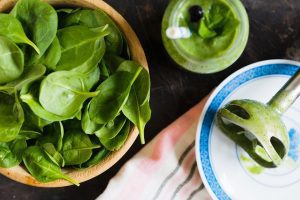
Table of Contents
Nutritional Benefits of Spinach
As there are different types of spinach, the nutritional benefits expand to a great extent. Check out some of the significant benefits below:
1. Iron
An absence of iron in the eating routine can influence how effectively the body utilizes energy. Spinach is an extraordinary wellspring of iron. Adding nutrient C-rich nourishments, for example, organic citrus products with plant iron like spinach to improve ingestion comes as a significant health tip.
2. Calcium
Spinach contains roughly 250 mg of calcium for every cup. Notwithstanding, it consists of much fewer nutrients compared to calcium, which is derived from dairy sources. The different types of spinach come with a high oxalate content, which ties to calcium and makes it difficult for our bodies to utilize, thus storing the energy.
3. Magnesium
Spinach is additionally probably the best wellspring of dietary magnesium, which is fundamental for energy digestion, keeping up muscle and nerve work, ordinary heart cadence, a solid, resistant framework, and keeping up pulse. Magnesium, likewise, has an impact on hundreds of more biochemical responses that happen in the body.
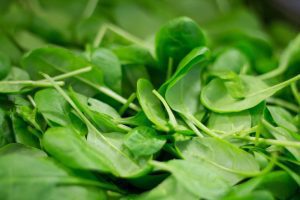
Related Reading:
15 Healthiest Vegetables to Lose Weight
Health Benefits of Spinach
Spinach is a superfood, which is stacked with loads of supplements in a low-calorie bundle. Though dull and verdant, the types of Spinach prove to be significant for skin, hair, and bone wellbeing. These, additionally immune the body with protein, iron, nutrients, and minerals.
The potential medical advantages of devouring different types of Spinach incorporate improving blood glucose control in individuals with diabetes, bringing down the danger of malignancy, and enhancing bone wellbeing.
Eating the different types of Spinach has the following possible health benefits:
1. Diabetes management
The different types of Spinach contain a cell reinforcement known as the alpha-lipoic corrosive, which has been observed to bring down glucose levels, increase insulin affectability, and forestall oxidative, stress-instigated changes in patients with diabetes.
2. Cancer prevention
Spinach and other green vegetables contain chlorophyll. A few examinations have demonstrated chlorophyll to be powerful at impeding the cancer-causing impacts of heterocyclic amines. These are created when flame broiling nourishments at a high temperature. This can add to forestalling the development of disease as well.
3. Asthma prevention
Beta carotene proves to be highly effective when preventing asthma and restricting its symptoms. Spinach is high in a particular nutrient, is capable of aiding the symptoms of asthma.
4. Lowering blood pressure
Because of its high potassium content, different types of spinach are suggested for people with hypertension. Potassium lowers the impacts of sodium in the body. A low potassium admission may be as powerful a danger factor for growing hypertension as high sodium consumption.
5. Bone health
Low intake of nutrient K has been related to a greater danger of bone break. Satisfactory nutrient K utilization is significant for acceptable wellbeing. It works as a modifier of bone network proteins, improves calcium assimilation, and may diminish the measure of calcium that leaves the body through urination.
6. Healthy skin and hair
The different types of spinach have huge amounts of nutrient A, which directs the creation of oil in the pores of the skin and hair follicles to saturate the skin and hair. It is this oil that can develop to cause the skin to break out. Nutrient A is likewise essential for the development of every real tissue, including skin and hair.
The spinach, high in nutrient C, is significant for the structure and upkeep of collagen production, which gives structure to the skin and hair.
7. Diet
The Spinach leaves can be a scrumptious and nutritious expansion to a plate of mixed greens. Spinach is an adaptable vegetable and can be eaten crudely or cooked.
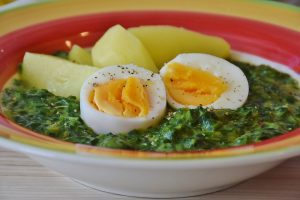
Some tips you can incorporate different types of Spinach into a daily routine
- Add spinach to pasta, soups, and meals.
- Softly sauté spinach in a limited quantity of additional virgin olive oil.
- Season with newly ground dark pepper and newly ground Parmesan cheddar.
- Add spinach to a wrap, sandwich, or flatbread.
- Make a plunge with spinach, for example, spinach and artichoke plunge or spinach and goat cheddar plunge.
- Add a small bunch of new spinach to an omelet or scramble, or toss a small bunch into a smoothie

Risks of having Spinach
Here are some of the risks associated with the varieties of Spinach:
- On the off chance that somebody is taking blood-thinners, for example, warfarin, it is significant that they don’t unexpectedly start to change the measure of food they eat containing nutrient K, which assumes an enormous part in blood coagulating.
- Burning through an excessive amount of potassium can be unsafe for those whose kidneys are not completely utilitarian.
- If the kidneys can’t eliminate the abundance of potassium from the blood, it very well may be deadly. Significantly, individuals with kidney issues don’t devour perilous degrees of potassium.
Factors for growing different types of Spinach
The factors which influence the growth of the different types of spinach are:
1. Temperature and Weather
Any weather is ideal for growing spinach. The average temperature ranges from 25°F to 75°F, so the season hardly makes a difference. However, the seeds require at least six weeks of coolness to mature into a leafy and healthy spinach plant.
2. Type of Soil
Considering the Spinach in India, the type of soil matters to a great extent. While some spinach plants require dry soil, some require the wetlands to grow and mature.
3. Location
The best weather condition for the spinach to grow is in full sunlight and partial shade. Apart from it, the soil needs to be moist and fertile as well for better growth.
Know the right technique
If you are unsure of your soil, growing different types of Spinach on it to know what suits it is the best thing to do.
Knowing the right technique to plant your spinach makes a world of difference. So, before you sow the seeds, do some research, and learn more about it.
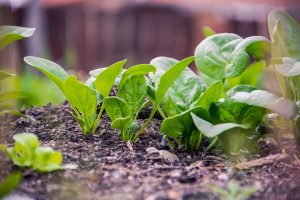
Different Types of Spinach:
We broke down the Spinach varieties list by the types of leaves.
1. Savoy Spinach
Savoy spinach, likewise called wavy leaf spinach, has creased wavy leaves that are exceptionally dull green. Given its fresh surface and marginally harsh flavor, savoy spinach is best utilized for cooking, rather than being eaten crudely.

Some of the Savoy Spinach Types are:
1. Hammerhead Spinach
These are curled, and round savoy spinach type and have leaves, which are dark green. They, however, tend to be a rich source of fiber and taste delicious. The particular type is usually consumed raw and also included in a variety of salads. This spinach comes with a harvest period of 27 days and thus grows quite faster.
2. Bloomsdale Spinach
These spinach types are often referred to as the gardener’s favorite and come as another variety of savoy spinach. Unlike the Hammerhead spinach, they have medium-dark greenish colored leaves with heavy curls. They come with a minimum estimated growth rate and can be harvested within 45 days. The best part about spinach is that they grow well even in freezing temperatures. They taste amazing when prepared as salads.
3. Palco Spinach
Palco belongs to the savoy type of spinach and has extremely cupped and curled and dark greenish leaves. The best part about the particular spinach is that it can adapt itself promptly to extremely high and low temperatures and comes with only a 38-days harvest period. However, this spinach proves to be highly resistant to diseases and helps to build immunity.
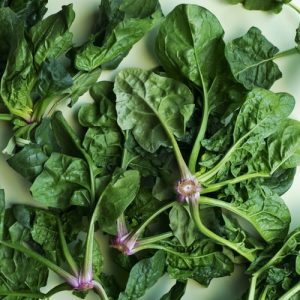
4. Regiment Spinach
This spinach belongs to yet another category of the savoy palak varieties and extends to a great variety such as tender, large, and curly. The leaves are quite big and have a deep green color to them and can be eaten raw or in salads after tossing them slightly.
3. Semi-Savoy Spinach
Semi-savoy spinach has semi-creased leaves with a similar fresh surface as savoy spinach. It is simpler to clean than savoy spinach and should likewise be utilized in cooking. They are commonly seen to be filled in home nurseries.
1. Carmel Spinach
These upright and fast-growing spinach plants fall in the category of semi-savoy types of spinach. Besides their enormous benefits, they have dark green leaves, which look quite attractive and make into delicious salads. This type of spinach has beautiful and dark green leaves. Within 25 days, baby leaves can be spotted in the plant, and it may take up to 5 weeks maximum for them to mature and grow.
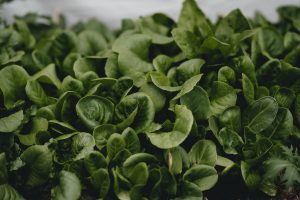
2. Emperor Spinach
The particular type comes with great variety and is next in the semi-Savoy types of spinach. Besides its deep green leaves, the spinach plant also comes with a long stem, making the bunching process a lot easier.
3. Kookaburra Spinach
Belonging from the semi-Savoy different types of saag leaves, these are dark greenish leaves with a slightly curved shape. Unlike other spinach plants, these are usually found in the home gardens, where they can fully mature within 26 days to 37 days.
4. Acadia Spinach
Deriving existence from the semi-savoy types of spinach, the Acadia spinach comes in dark green color with an oval shape. With a medium growth rate, these spinach plants come with a harvest period of 27 days.
5. Tasman Spinach
Coming from the semi-savoy type, Tasman belongs to the semi-savoy type of spinach group. They come with a fast harvest growth of 4 weeks and the medium green leaves look beautiful. As the plant has fast bolted, planting them during the early spring can be ideal.
6. Reflect Spinach
They belong to the semi-savoy type of spinach and in comparison to the other spinach type. If you have seen this plant’s spinach picture, you would know that these have oval-shaped leaves and have a linear structure. With a 28-days harvest period and medium growth rate, these are quite popular.
7. Kolibri Spinach
The particular spinach type belongs to the semi-savoy group and has slightly curled leaves with a medium-dark green and smooth surface. The excellent variety, with a harvest period of 29-days, can be picked and used once it grows fairly.
8. Teton Spinach
With an upright structure and oval-shaped leaves, the dark green leaves enhance the beauty of the spinach plant and taste quite delicious when added to salads. They come with 6 to 7 weeks of the harvest period and are quite resistant to mildew.
9. Indian Summer Spinach
Unlike other semi-savoy spinach plants, the particular one can be grown throughout the year, and in all three seasons, that is, summer, spring, and fall. The slightly curled yet flat leaves with a dark greenish tinge to it make all the difference. This spinach comes with a harvest period of 7 weeks and is quite resistant to bolting.
10. Catalina Spinach
The semi-savoy spinach type belongs to the variety of spear-shaped leaves, with slight curls and thickness. This is a semi-savoy type of spinach. With an approximate harvest time of 28-days, these Catalina Spinach comes with a reasonable bolting period.
11. Tyee Spinach
The semi-savoy group of spinach comes with dark green, heavy, and oval-shaped leaves. This type of spinach has an amazing fragrance, which forms to be the best part of their consideration. These leaves, with a harvest period of 45 days, make the most delicious salads.
12. Crocodile Spinach
The particular group of semi-savoy spinach comes with a harvest period of 56 days and is highly tolerant to heat, and can thus grow ideally in hot temperatures. If you have seen the picture of the Spinach plant you may know that it has bright green and oval-shaped leaves and takes almost four weeks for the baby leaves to grow and add in salads.
13. Avon Spinach
With a harvest period of 6 to 7 weeks, the Avon Spinach belongs to the semi-savoy group of spinach and stands out to be the most delicious when cooked in salads. The large and dark green leaves with slight curls in them are healthy and ideal for freezing.
4. Smooth-Flat Leaf Spinach
Smooth Leafed Spinach with smooth and level leaves are anything but difficult to clean and are generally utilized for making wraps. Described by its smooth, spade-formed leaves, delicate surface, and marginally sweet flavor, level leaf spinach has become a backbone of most general stores and serving of mixed greens bars.
It is best eaten crude and is sold free or pre-washed and bundled. Child spinach is a kind of level leaf spinach that has been picked in the beginning phases of development when the leaves are especially little, delicate, and sweet.
5. Space Spinach
The variety from the smooth-flat leaf spinach comes with the leaves, which are in the shape of flat leaves with rounded and smooth edges according to the Spinach plant images available online. However, the growth rate is quite fast as it grows within 40 to 45 days.
6. Gazelle Spinach
With dark green leaves, the Gazelle Spinach comes with straight leaves with round edges, which look great and have a smooth texture. This type of spinach is smooth, fine, and straight-leafed spinach. They have a fast growth rate with a harvest period of 26 days. They are suitable and yield well during the fall harvest season. They have good flavor and are suitable for making a delicious salad.
7. Corvair Spinach
The particular spinach with straight and oval-shaped leaves comes with a dark greenish color. With a medium growth rate and a 27-days harvest period, they ensure slow bolting.
8. Flamingo Spinach
The particular type of spinach with straight leaf and uniform and smooth leaf structure comes with a sharp arrow tip. It is a particular feature that makes it different from the other spinach. They have a fast growth rate of 27 days and a medium bolting speed.
9. Red Kitten Spinach
The spinach with straight and uniform leaves are medium green in color and have a dark red vein structure on the surface. This spinach has fast growth of 26- 30 days and should be harvested early. It is because they have very fast bolting speed.
Related Reading:
All About Dehydrated Spinach
How to buy different types of Spinach?
Spinach is sold new in packs or pre-washed in sacks, solidified, and canned. New spinach is broadly accessible all year. When purchasing entire lots of spinach, search for fresh and dim green leaves and maintain a strategic distance from those that are yellow, limp, or shriveled.
While purchasing pre-washed, bundled spinach, review the pack for any vile or yellow leaves, and check the termination or a “best whenever utilized by” date.
How to use Spinach?
Spinach can be sandy regardless of whether it’s pre-washed, so flush it in a lot of water. Fresh spinach ought to be stemmed; the leaf needs to be squeezed and pulled the stem up the leaf’s spine. When cooked, spinach will diminish enormously in volume; you need around two pounds of spinach for four cooked servings (around three cups).
Spinach contains a fair amount of water. If you are adding cooked spinach to a quiche filling, remove the excess moisture. You can do this by wrapping the spinach in a kitchen towel, twisting both ends. It will look like a wrapped piece of hard candy, and squeezing until it’s as dry as possible is important.
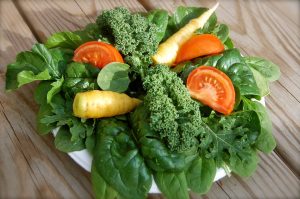
Frequently Asked Questions
Here, we have answered a few interesting FAQs about the different types of spinach available around the world.
1. How many varieties of spinach are there?
You can find over 10 different varieties of spinach, some of which are
- Savoy Spinach
- Semi-Savoy Spinach
- Smooth-Flat Leaf Spinach
- Space Spinach
- Gazelle Spinach
- Corvair Spinach
- Flamingo Spinach
- Red Kitten Spinach
2. What type of spinach is easiest to grow?
The Semi-Savoy spinach variety is the one which you can grow easily at home with less maintenance as they resist disease and bolt.
3. What is the best spinach to eat for your health?
Every variety of spinach is healthy in one or the other form. Try inculcating the maximum varieties to your diet to obtain the health benefits.
4. Why should we not eat spinach at night?
It is best to consume spinach in moderation, as excess consumption may have a toxic effect on the body. Furthermore, you may have stomach issues such as bloating, cramps, gas, and many more.
5. What is the best tasting spinach?
Semi savoy variety is one of the best tasting spinach. Some of the best tasting semi savoy spinach are Bloomsdale Longstanding, Melody, and Olympia.
Conclusion
Now that you have a thorough guide about the different types of Spinach, the scientific name of spinach or palak botanical name, with yourself in the array, it is time for you to give them a shot in your garden. Happy gardening!


